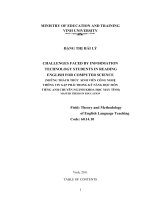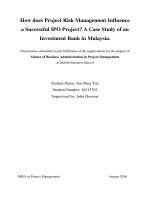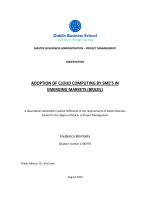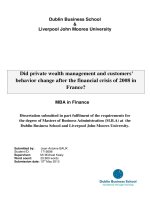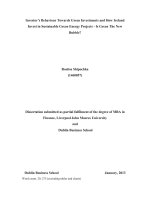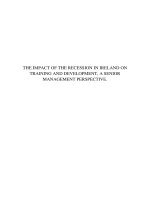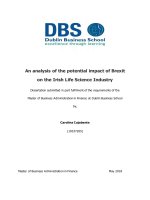Master Thesis in Economics: Main Challenges faced by Multinational companies when planning Human Resources in Venezuela
Bạn đang xem bản rút gọn của tài liệu. Xem và tải ngay bản đầy đủ của tài liệu tại đây (846.1 KB, 70 trang )
MBA
Main Challenges faced by Multinational
companies when planning Human
Resources in Venezuela
Tabayre Ríos Gaudens
Student Number 1712248
May 2013
Word Count: 18,431
A thesis presented to Dublin Business School and Liverpool John Moores'
University in fulfillment of the requirements for the award degree of Masters of
Business Administration in Business Management under the supervision of Mr.
Eddie Mcconon.
May 2013
Table of Content
Abstract ..................................................................................................................................... 4
Acknowledgment ...................................................................................................................... 5
Chapter 1: Introduction .......................................................................................................... 6
Chapter 2: Literature Review ................................................................................................. 8
2.1 The Importance of HRP as a part of the Business Strategy ............................................. 8
2.2 HRP Process..................................................................................................................... 9
2.3 HRP in MNCs ................................................................................................................ 12
2.4 Main Challenges faced by MNCs when planning HR in Venezuela ............................. 16
2.4.1: Legal restrictions.................................................................................................... 19
2.4.1.1 The Venezuelan Organic Labor and Worker‟s Law ............................................ 19
2.4.1.2: Special Bar Against Dismissal ............................................................................ 19
2.4.1.3: Exchange Control ............................................................................................... 24
2.4.2: Socio-economic factors.......................................................................................... 25
2.4.2.1: Influence of social factors in recruitment ........................................................... 25
2.4.2.2: Inflation ............................................................................................................... 27
Chapter 3: Methodology........................................................................................................ 29
3.1 Research Question ......................................................................................................... 29
3.2 Proposed Methodology .................................................................................................. 29
3.2.1: Research philosophy .............................................................................................. 30
3.2.2: Research approach ................................................................................................. 31
3.2.3: Research strategy ................................................................................................... 31
3.2.4: Research Choice .................................................................................................... 31
3.2.5: Time Horizon ......................................................................................................... 32
3.2.6: Qualitative .............................................................................................................. 33
3.2.7: Non-probability sample ......................................................................................... 33
3.2.8: Operationalization .................................................................................................. 34
3.3 Ethics.............................................................................................................................. 34
2
3.4 Limitation ....................................................................................................................... 35
Chapter 4: Data Analysis and Findings ............................................................................... 37
4.1 Data collection .............................................................................................................. 37
4.2 Sample........................................................................................................................... 37
4.3 Results from interviews ................................................................................................ 37
Chapter 5: Conclusions ......................................................................................................... 48
Chapter 6: Self-reflection on own learning & peformance ................................................ 50
6.1 Introduction ................................................................................................................... 50
6.2 Personality and experience ........................................................................................... 50
6.3 Learning process ........................................................................................................... 50
6.4 Skills identified during the learning process ................................................................. 52
6.5 My learning style preference ........................................................................................ 53
6.6 How can I continue to become more effective learner ................................................. 53
6.7 Conclusions ................................................................................................................... 54
Bibliography ............................................................................................................................ 55
Appendix .................................................................................................................................. 58
3
Abstract
Human Resources Planning has been in consider a key factor for the development of companies
and its success is highly reflected in the markets nowadays. Such planning may varies from
country to country and therefore, the aim of this research paper is to explore whether Human
Resources Planning can still be consider of relevance within Multinational companies in
Venezuela given the main challenges faced when planning its operations in this country.
The influence of external factors prevailing in Venezuela, such as legal restrictions and socioeconomic problems in the Human Resources Planning has been analyzed in detail through this
paper in both the academic and the field perspective. As a result, this study lead us to understand
that even though planning plays an important role for Multinational companies, the skill of
improvising and being flexible with said planning has an important role in particular
environments such as the ones currently present in Venezuela.
It is shown that due to the existence of those particular challenges, global policies and practices
should be adapted in order to fulfill the reality of this country. In addition, it was evidenced that
recruiting and retaining the right people has become a hard task in Venezuela as a consequence
of the increasing brain drain that affects the country.
4
Acknowledgement
This research study about the main challenges faced by Multinational Companies when planning
HR in Venezuela completes my MBA in Business Management studies at Dublin Business
School. I would like to show my gratitude to all the interviewees who were kind enough to share
their time and ideas with me during the interviews.
I want to thanks my family and friends for all the support and understanding during these twelve
weeks writing my dissertation.
5
Chapter 1: Introduction
Human Resources (HR) is considered nowadays a business partner that plays an important role
within the organisations. Bahuguna, Kumari and Srivastava (2009, p.567) have stated that the:
“HR department now became more than a business function: it is a business partner, reaching out
to support lines of business”. Thus, HR department must work in partnership with other business
units to ensure the integration with other management functions.
According to Anyim, Mba and Ekwoaba (2012):
"For good business performance, it is important that manpower planners become a
strategic partner with the business planners. For a long time, scholars in organizational
development (OD) have maintained that improvement in business performance is directly
tied to efficient manpower planning and closely linking the plan to strategic objectives.
However, what some practitioners do not realize is that the answer is not necessarily on
the application of the latest management principles but rather it is on the comprehensive
integration of manpower planning with business plans and strategic objectives" (Anyim,
Mba and Ekwoaba, 2012, p.61)
Making the best possible use of HR have become crucial in designing the strategy of the
organisation, and hence one of the most important priorities for managers. In particular, HR
Planning (HRP) -also known as “manpower planning”- has been understood as a vital activity
since a contemporary approach suggests that the success of the organisations depends largely on
its employees. In this respect, Gunnigle, Heraty and Morley (2006) state:
“For example, as Snell [2005] and others have argued, in the current era of increased
competition and globalization, many of the traditional sources or competitive advantage,
such as barriers to entry [e.g. monopolies], technology and access to capital, have become
6
less important, with the result that HR and HR processes can emerge as key sources of
competitive advantage” (Gunnigle, Heraty and Morley, 2006, p. 44).
Notwithstanding the foregoing, in some jurisdictions believe that planning has become less
important due to the fact that we live in an uncertain environment. However, even though
planning has become more difficult nowadays, it is still important. In the particular case of
Venezuela, planning is even more challenging due to factors that are foreign and out of the
control of the management of each company. Therefore, making a good HR plan in Venezuela
implies not only analyzing the specific challenges present in this country but also how to manage
and adapt the HR global policies imposed by the head office to face those challenges.
In that line of thought, and bearing in mind how Multinational Companies (MNCs) operate under
different environments, Kapoor (2011, p.46) sustains that “Only the multinationals that will be
willing to adapt their human resource practices to the changing global labor market conditions
will be able to attract, develop and retain the right talent, and will likely succeed in the global
competition”.
Through this paper we will illustrate the main challenges faced by MNCs in Venezuela in
conducting the planning of HR, how external factors can influence the decisions and the actions
that must be taken by these companies and how is managed this situation in connection with
other countries.
It is also intended to highlight the importance that HRP still represents,
especially in MNCs that operate in complex environments like Venezuela, and how it positively
influences the achievement of the organisation‟s goals, by providing a better understanding on
how said HRP helps MNCs in Venezuela to deal with mobility of employees, assigning global
tasks, managing a global workforce and adapting the strategies and plans in this special and
complex environment.
In order to illustrate the relevance of this research work, it will be explained the importance of
HRP as a part of the business strategy. Then, we will provide an explanation of the process that
must be considered when planning is carried out, how HRP is managed within MNCs to finally
address the main challenges faced by MNCs operating when planning HR in Venezuela. We
7
hope this research offers an important contribution to HR students and professionals in this area
from a practical point of view, in both Venezuela and other jurisdictions that might experience
similar circumstances in its working environment.
Chapter 2: Literature Review
2.1 The importance of HRP as a part of the business strategy
A contemporary approach suggests that the success of the organisations depend largely on its
employees. This is supported by Anyim, Mba and Ekwoaba (2012, p.58) who have affirmed that
“Since the beginning of the 21st century, there has been increasing claims that the route to
competitive advantage is achieved through people”. According to this, it is possible to sustain
that the better an organisation employs its human resources the better its development will be.
HRP seeks to identify the needs of the organisation in terms of HR in order to create a plan that
ensure that organisations count with the appropriate number and qualified personnel to meet
those needs. In this regard, Batholomew (2012, p.471) sustains “The essence of manpower
planning is summed up in the aphorism that its aim is to have the right numbers of people of the
right kinds in the right places at the right time”. Thus, HRP can ensure a more accurate use of
the HR, which implies more satisfied and better trained employees. Also, hiring the correct
people or anticipate fluctuations in hiring needs can result not only in reducing cost for
organisations but also in improving their performance and reducing employee turnover. This can
be done through an effective HRP designed in connection with the strategy of the organisation.
Indeed, HRP must be linked with the corporate strategy in order to contribute in the achievement
of the goals set by the organisation. In this regard, Reidy (2011) explains:
“Human resource planning is of major importance because the organisation needs to be
prepared as far as possible for changes in its internal and external environments. HR
planning helps to prepare the organisation to deal with future staff and skill requirements
8
so that it can be achieve its strategic objectives […] HR planning is an essential part of
the overall corporate strategy […] making decisions on whether to recruit or train
employees depends on organisational plans […]” (Reidy, 2011, pp. 23-24).
Based on the foregoing, linking the corporate strategy with the HRP becomes vital in order to
succeed in these difficult times. In this regard, Jackson and Schuler (1992, p. 235) said “Because
the purpose of human resource planning is to ensure that the right people are in the right place at
the right time, it must be linked with the plans of the total organization”.
On the other hand, HRP in MNCs will depend on how they are globally organized. According to
Gunnigle et al. (2007):
“Previous research on MNC subsidiaries has distinguished between those that are
autonomous, those that are controlled from higher levels and those that are the source of
information and resources for other sites (cf. Gupta and Govindarajan, 2000). In the
parallel UK study, Edwards et al., (2007: 17) posit three potential scenarios regarding the
role of the HR function: An autonomous HR function […] A controlled HR function:
[…] A limited autonomy HR function” (Gunnigle et al., 2007, p. 20).
However, whatever the form of organization is, HRP should be provided in connection with the
business strategy. In this regard, Anyim, Mba and Ekwoaba (2012, p.58) has indicated that:
“there must be congruence between business plan and manpower if the organization‟s vision,
mission and objectives are to be achieved […] Integrating the manpower planning function with
business plans means aligning decisions about people with decisions about business projection”.
2.2 HRP process
As stated previously, competitive advantage can be gain through people. Thus, in order to
achieve the competitive advantage, it is required to design the HRP with the business strategy.
In conducting HRP, it is necessary to follow a process, which entails a set of steps that allow
9
organisations to determine the right number of employees with the required skills according to its
goals.
A traditional approach suggests that the HRP process include four stages. In accordance with
Gunnigle, Heraty and Morley (2006):
“The planning process […] identifies four key stages in the human resource planning
process: stocktaking; forecasting; planning; and implementing […] all these stages are
interlinked and thus form a cycle whereby human resource planning affects, and is
affected by the range of human resource policy choices that the organisation has available
to it” (Gunnigle, Heraty and Morley, 2006, p. 95).
Based on the foregoing, there are basically four HRP stages: stocktaking, forecasting, planning
and implementation, which can be briefly explained as follows:
1. Stocktaking. It involves analyzing the existing situation within the organisation. It does
not implies only the evaluation of the needs of the organisation in terms of personnel and
skills but also, but also the external factors that can affect the organisation (e.g. employee
mobility, economic and legal factors, among others).
In this regard, Macaleer and
Shannon (2003, p.16) state that organisations must “Understand the internal and external
factors that may affect the achievement of the objectives that will ultimately impact the
programs and services you will provide”.
Stocktaking is relevant because the
organisation needs to know how many people need to be working and in what jobs to
implement organisational strategies and attain organisational objectives;
2. Forecasting. In words of Pilbeam and Corbridge (2006, p. 97) forecasting “involves the
comparison between the identified supply of labour and the quantified demand for labour
in terms of the skills and competencies needed to achieve the corporate aims”. Thus, the
aim of forecasting is to determine the number and type of employees needed in the future.
As observed, forecasting is important because without it organisations cannot asses the
10
disparity between supply and demand nor how effective a HRP program is in reducing
said disparity ;
3. Formulation of the plan. Once the organisation has identified the current resources and
the staff required, it can proceed to elaborate the plan. The organisation develops action
plans based on the gathered data, analysis and available alternatives.
It has been
suggested that when creating the plan some elements should be considered. In this
regard, Reidy (2011, p. 32) refers: “Beardwell and Claydon (2007, p.175) suggest
formulating plans under the following headings: resourcing […] flexibility [...] retention
[…] downsizing”.
4. Implementation. According to Gunnigle, Heraty and Morley (2006, p. 103) “On
completion of the human resources plans, the organisation operationalizes its decision
and the cycle is once again set in motion”.
Also, it is important to bear in mind that HRP is an ongoing process that must be updated
depending on several factors such as particular needs of the organisation, legal and
economic changes, among other.
Reidy (2011, p.33) supports this by stating that
“organisation‟s internal and external environments need to be monitored for any signs of
change and plans need to be reviewed in light of any changes that occur in these
environments”.
For some authors, the above mentioned process seems to be limited in order to fulfill staffs
requirements since the HRP process should include other areas. In this regard, Macaleer and
Shannon (2003) state:
“The human resources planning process must consider not only specific staff needs, but
also areas such as: Services to be provided in support of the specific strategic objectives
and the cost and timing for these services. Prioritization of the strategic objectives and
identification of the specific services to support those objectives with cost/benefit
analysis” (Macaleer and Shannon, 2003, p.18).
11
This approach suggest that HRP process is a set of activities that go beyond recruiting the
required staff, which can be understood as a strategy-based HRP process.
Additionally, it is important to mention that there are different models and ways of planning.
Thus, it will depend on the one specific model chosen by the organisation. As observed, HRP
involves having the right number of qualified people in the right jobs at the right time. Hence, it
is possible to sustain that having an adequate HRP process is an important tool in order to
achieve successfully the objectives of the organisation.
2.3 HRP in MNCs
The success of organisations both nationally and internationally requires planning and
anticipating possible actions and solutions in all areas, including HR. As a consequence of the
globalization, HRP is not only about analyzing and calculating the demand and supply of HR
across the organisation but also about mobility of people, management of cultural and
geographical differences and developing a global mindset among their employees.
Labor mobility (mobility of people) refers to the geographic and occupational movement of
employees while international labor mobility is the movement of employees between different
nations. There are two typical forms of international assignments: expatriation and inpatriation.
Expatiation means transferring parent country nationals from the head office to a subsidiary
while inpatriation refers to transferring host-country nationals from the foreign subsidiary to the
head office.
Normally, when the objective is empowering the capacity of local adaptation, MNCS tend to use
local talent. However, under certain circumstances, organisations choose to assign expatriates to
help the head office to understand the local conditions and control the operations of the
subsidiary. In this regard, Serafinceanu et al. (2010) say:
“Sometimes managers from the country of origin of the company are required to train the
personnel. The need for expatriated occurs when certain qualities and experiences are
12
required in a certain place, when there is a significant need for integration in the
multinational company of the other divisions in the world and when the needs cannot be
met on a local level” (Serafinceanu et al., 2010, p. 323).
Thus, managing employee mobility becomes important because without the right training and
planning, employees moving to foreign countries will not be prepared to meet the challenges
present in those countries.
In that sense, it should be noted that planning becomes important in order to be productive by
taking advantage of its resources (HR), and therefore, being prepared to address the issues
related to employee mobility should be included in the company‟s strategic planning.
According to Lazarova (2006) MNCs:
“need to be aware of the local HR context in each country that hosts a subsidiary of
theirs. In turn, their HR departments need to develop and coordinate HR policies and
programs that cut across a variety of nations, each with its own historical, political, legal,
economic, social and cultural characteristics” (Lazarova, 2006, p. 36).
Notwithstanding the foregoing, it is important to mention that there are some factors
conditioning the transfer of personnel that should be carefully addressed. Serafinceanu et al.
(2010) noted that:
"The first factor conditioning the transfer of resources from the parent organization to the
daughter companies is the way they are organized, since they can be self standing
daughter companies of the parent company or can be formed by a local partnership.
Certain similarities or differences can thus occur between the way the parent- and the
daughter- company are organized, which can facilitate or impede the implementation of
human resources policies and practices specific to the parent organization at the level of
the daughter companies” (Serafinceanu et al., 2010, p.319).
13
There are different modalities in which companies can run their HR activities at international
level. For example, the Perlmutter‟s model identifies four modalities, which are:
1. Ethnocentrism: parent organization has a direct control on the daughter company in the
host country;
2. Polycentrism: daughter companies are relatively independent from the parent company,
which means that policies and practices are adapted to local needs;
3. Geo-centrism: MNCs are seen as an international entity and the HR policies are
implemented to maximize global results; and
4. Region-centrism: MNCs‟ activities are carried out at the level of regions.
Identifying the model used by the MNCs is important because according to Serafinceanu et al.
(2010, p.315) it “highlights the way in which multinational companies develop and implement
human resources‟ strategies and policies at the level of daughter companies in the host
countries”.
Likewise, management of cultural and geographical differences and developing a global mindset
among their employees is a difficult task that must be planned in advanced.
Cultural training refers to the preparation of employees from several cultures to work together
while diversity training refers to the instruction of a person or a group for living in another
country (e.g. training for expatriates and their families).
In this regard, Malik and Aminu (2011, p.319) indicate that “To achieve success in global
marketplace, the challenge of all businesses regardless of their size is to understand global
corporate cultural differences and invest in human resources”. Likewise, Pucik (1996, p.2)
affirms that “To succeed in global competition requires an open and empowered organizational
climate but also a tightly focused global competitive culture”.
14
Consequently, companies must be flexible aligning people management practices to cultural and
institutional norms governing the local market. For these reasons, a cross cultural training and
diversity training must be included in the HRP.
Besides, even though MNCs must adapt to local conditions, it must also keep a stable sign of
identity. Thus, the development of different HR practices (e.g. selection, rewarding, training) for
employees of different subsidiaries can generate unfairness problems between them and causes
problems of corporate image. Therefore, organisations must implement global policies and
practices, and adapt them only when is necessary according to the circumstances of a particular
jurisdiction. According to Serafinceanu et al. (2010):
“All the relationships developed at the level of a multinational company ensures both its
integration, and differentiation of its practices of human resources at the level of it
daughter companies. Essentially this is the role of international strategic management of
human resources. This is because the implemented human resources practices at the level
of daughter companies include, more or less, specific elements to the local context where
they run their activity (economic, political, cultural, social, institutional, legislative etc.
environment)” (Serafinceanu et al., 2010, p. 322).
Meanwhile, developing a global mindset is oriented to facilitate some competencies such as
flexibility and openness to experience.
It also allows employees to know organisational
structure, increase networking and developing skills such as work efficiently in different
environments.
In words of Pucik (1996, p.4) “having a „global HR mindset‟ implies a
recognition of benefits that can flow to the whole organization from encouraging and valuing
cultural diversity in people, not just as members of distinct cultural groups but as individuals”.
On the other hand, Bonache and Stirpe (2011) sustain:
“Multinational companies are faced with the challenge of managing a global workforce.
Success in this regard calls for careful HR planning […] dealing with mobility not only
as regards staff (expatriates, impatriates and third country nationals), but also as regards
15
positions (task relocation) and know-how (transnational team training)” (Bonache and
Stirpe, 2011, p.73).
According to the abovementioned, other factors such as task relocation must be considered by
MNCs when designing the HRP. Task relocation (offshoring) refers to move jobs to other
countries (an office, a complex function, etc.) and involves seeing the world as a global labor
market. Some reasons justify Offshoring. For example, offshoring the less qualified manpower
can reduce costs substantially. Furthermore, having access to more qualified personnel brings the
benefit of having access to a superior talent that allows the organisation to gain a competitive
success. It also can improve the operating efficiency.
As observed, HRP in MNCs are challenged, especially when said MNCs operate in countries that
present uncertain environments such as the case of Venezuela.
2.4 Main Challenges faced by MNCs when planning HR in Venezuela
Venezuela is a South American country that currently faces serious political, social and
economic problems, which are constantly reflected in ever changing laws and administrative
rules imposed by the government. Therefore, planning in Venezuela becomes more difficult
every day due to its unstable and uncertain environment that highly affects the performance and
development of MNCs in many ways.
As a consequence, organisations in Venezuela must take decisions depending on those changing
factors, which might lead to the idea that long-term planning can be seen as less important
nowadays. In this sense, Armstrong (2009) stated:
“Summarizing the problem, Taylor (2008) noted that: It would seem that employers,
quite simply, prefer to wait until their view of the future environment clears sufficiently
for them to see the whole picture before committing resources in preparation for its
arrival. The perception is that the more complex and turbulent the environment, the more
important it is to wait and see before acting” (Armstrong, 2009, p. 488).
16
Nevertheless, although planning is becoming more difficult especially in countries like
Venezuela, it still remains as a very important function within HR and should be taken into
consideration when designing the strategy of the organizations. In this regard, Farnham (2006)
explains that:
"manpower planning is important because it encourages employers to develop clear and
explicit links between their business and human resources plans, and to integrate the two
more effectively. It allows for better control over staffing costs and numbers employed
and it enables employers to make more informed judgment about the skills and attitude
mix in organizations" (Farnham 2006 cited in Anyim, Mba and Ekwoaba, 2012, p.57).
It is known that several internal and external factors can influence the way a business is being
conducted. In the particular case of Venezuela, it is possible to argue that planning becomes a
hard task when compared with stable countries such as United States of America or countries of
the European Union. According to Anyim, Mba and Ekwoaba (2012, p.56) "Planning has
become more complex, particularly in this present time of increasingly turbulent business
environments, which increases the tensions between the greater need for planning and the greater
difficulties of prediction".
Venezuela is a country situated at a strategic geographic location whose main source of income
is oil. Also, Venezuela had, during the 1900s, a stable legal framework that provided security for
investors. Consequently, it used to be an attractive market where many countries wanted to
invest in (especially those in the oil industry sector).
Nevertheless, Venezuela has suffered several changes from 1999 that have affected its economy
and stability, since the country experience a change in its constitution and subsequently (by
government decisions and later implementation of laws aiming to that end) entering in a new
scheme of government and economy that even when label as “social” it is not quite yet define,
presenting contradictory realities for the businesses that take place in the country.
As a
consequence, doing and conducting a MNC in Venezuela has become a complex task, especially
when planning finance and HR.
17
Nowadays, trying to adapt and adequate global policies imposed by the head office to the
Venezuelan reality and needs must be managed in a different way compare to other countries. In
accordance to Bent et al. (2005):
"Successful corporate management in these turbulent and competitive conditions require
from management the development and adaptation of enterprise functional strategy; fast
and consistent implementation of strategies in business plan and a high degree of
flexibility and adaptability to changing business situations (Bent et al., 2005, p. 138)".
For the anticipation of the needs of a business, a stable environment is ideal since it reduces
variables and therefore risks.
In words of Anyim, Mba and Ekwoaba (2012, p.57) "The
integration of business and manpower planning is likely to be more appropriate in a stable
market place with largely passive (and static) customers, and with scope for long-term
forecasting because of the predictability of demographic change".
Planning is more difficult where the rules can be changed in any moment without having any
guarantee that the laws will be respected and the economy will not vary abruptly. A country
could be considered unstable when is liable to fall or sway its economy or its legal framework
(for diverse reasons), which can bring devastated consequences for the different aspects of the
development of its businesses (either directly over the finances or market practices, or indirectly,
through employment related conditions that can turn in the unviability of the business).
According to Thompson (1967, cited in Jackson and Schuler, p. 224). “Uncertainty can interfere
with efficient operations, so organizations typically attempt to reduce its impact; formal planning
is one common tactic used by organizations to buffer themselves from environmental
uncertainty”.
Bearing in mind all the above mentioned, even though there are several challenges (internal and
externals) faced by companies when planning HR in Venezuela, two main challenges will be
analyzed as follows: the legal and the socio-economic.
18
2.4.1 Legal restrictions
In the past few years, several regulations have been enacted in Venezuela to increase employees‟
protections. The most recent is the Venezuelan Organic Labor and Worker‟s Law published in
May, 2012.
Also, one of the most representative measures that have strengthened the
employee‟s protection under the Venezuelan law is precisely the so-called special bar against
dismissal, enacted first in 2002 and later extended and amended through sixteen decrees.
Likewise, a foreign currency exchange control is enacted in Venezuela since 2003. All these
regulations will be analyzed as follows.
2.4.1.1 The Venezuelan Organic Labor and Workers’ Law
According to the Venezuelan Organic Labor and Workers‟ Law, all workers, with the
exceptions of senior or upper management employees and employees hired for an indefinite
term having no more than one (1) month of service, are protected and may not be dismissed
without just cause. The unjustified dismissal of such workers is null and void unless the
dismissal has been previously authorized by the Labor Inspector‟s Office.
When the employment relationship terminates for reasons not attributable to the worker, or when
the worker is dismissed without cause and elects not to be reinstated, the worker is entitled to an
indemnity equivalent to the value of his/her seniority benefits. This kind of measure increases
enormously the labor costs for the organisations.
2.4.1.2 Special bar against dismissal
The special bar against dismissal tends to protect employees for an indefinite term. According to
this measure, employers cannot dismiss protected employees, not even by paying them additional
compensation, unless the dismissal has been previously authorized by the Labor Inspector‟s
Office. The measure has been subject to changes since it was first enacted by a Presidential
Decree a decade ago, becoming more restrictive to employers.
19
Indeed, beginning in 2002 and as a part of the current Venezuelan state policy to protect
employees and regulate the labor market, the special bar against dismissal was enacted and then
extended and amended through sixteen decrees up to this date. What was initially conceived as a
short-term measure (and apply in such a form by previous governments in Venezuela) became a
permanent practice implemented by the government, allegedly to prevent the high rates of
unemployment.
The special bar against dismissal not only prohibits dismissing protected employees but also to
transfer them, or make unilateral changes in their working conditions (including salary or
benefits) that could deteriorate their employment protection. According to Roig (2011, p.1) the
bar against dismissal “Does not benefit anyone. If the best employees are not in the company, it
will become less competitive and companies will force to keep the less good employees”.
In general, medium and large size organisations are most likely to comply with the measure since
for them it is much more convenient and necessary for practical reasons since failure to comply
with this ban (as well as other imposed rules that are less aggressive for the business
environment) might lead not only to fines and proceedings against the company, but also to a
most immediate consequence which is the impediment for the issuance of permits granted by the
government, for instance, the „labor solvency certificate‟.
Indeed, companies in Venezuela are bound to obtain a „labor solvency certificate‟ issued by the
Ministry of Labor, which is required for several purposes related to the conduct of the business,
among others: (i) participate in binds and enter into agreements with the public sector (e.g. stated
owned companies); and (ii) purchase foreign currency form the Venezuelan exchange control
authorities at the official exchange rates.
Failure to comply with the bar against dismissal can cause the denial and even the revocation of
the labor solvency certificate.
Furthermore, being the subject of several positions for
reinstatement may call the attention of labor inspectors who can plan unexpected visits to the
employer and impose fines, if applicable.
20
But there are also severe financial consequences related to this ban, mostly with regards to the
expenses that such measure represents for the normal performance of a company, more
considering that certain organizations, due to the dynamics of its activities (and given the new
period of one month imposed by the law to activate the protection against dismissal without just
cause), tend to have a regular rotation of its personnel.
In that sense, we most highlight the communications received by the International Labor
Organization (ILO) in 2010 and 2011, where the Venezuelan Federation of Chambers and
Associations of Commerce and Production (FEDECAMARAS for its Spanish acronym),
declared that application of the special bar against dismissal could mean that employees agree to
financial compensation from their employers to avoid bringing the cases before the labor
authorities.
That is precisely what is happening in practice: employers are negotiating with employees
offering them attractive packages enticing them to agree to resign. The cost of the dismissal is
unpredictable since it would depend on the negotiation process with each employee that the
employer needs or desires to dismiss.
Dismissal of skilled employees tends to be more expensive than dismissal of less skilled
employees, since the formers would generally require more benefits in order to reach an
agreement. Although it varies from case to case and there is no clear parameter to determine
compensation and benefits, the attractive packages offered by employers trying to convince
protected employees by the bar against dismissal to sign a resignation letter, usually contain: (i)
the compensation established in the OLL for unjustified dismissal, (ii) a payment equivalent to
several month‟s wages, (iii) the amount the employee would have received for unemployment
insurance, and (iv) the extension of certain benefits, such as the company‟s health insurance. The
attorneys‟ fees are an additional expense that employers would have to consider to calculate the
cost of the total package.
Although this is an alternative for employers who under certain circumstances are forced to
dismiss employees, the big problem is not only how expensive it is to dismiss an employee, but
21
that until the agreement is reached, the real cost is unknown. Anyim, Mba and Ekwoaba (2012,
p. 60) indicate that “Employees compensation in whatever form remains a cost to the business
and affects the profitability of the organization". Consequently, even though salaries and labor
benefits represent a normal cost for the organisations, the payments made to negotiate with the
employee are costs not estimates by the companies and will affect its budget, making therefore
the projection of costs related to labor relationships very complex for the management.
According to employers‟ representatives, the extension of the special bar against dismissals
threatens the employment quality and affects the employers‟ competitiveness. As a consequence,
companies are forced to be extremely precautious when hiring personnel because the retirement
process has become difficult and the labor costs has increased substantially.
Representatives of the employers‟ organization FEDECAMARAS have affirmed that from the
beginning of the measure, companies are suffering performance deterioration where employers
cannot dismiss less efficient employees and do not hire new personnel afraid of the effects of the
measure. The Venezuelan Confederation of Industries (CONINDUSTRIA for its Spanish
acronym) also stated its concern for the loss of competitiveness that employees are suffering and
explained that expanding the range of protected employees does not help to create new jobs.
The measure causes pressure on the labor market, forcing employers to keep their employees
regardless of their work performance. According to the foregoing, this situation affects the HRP
because positions are being filled with the wrong people, and companies will have to take some
measures to solve this problem (e.g. negotiate with these employees their retirement from the
company which will increment cost or keep those employees and create new positions for them).
However, organisations generally react by diminishing the employees‟ demand on the market so
this type of measure discourages the creation of new jobs, at least in the public sector, which
depends upon an optimal management of its resources.
In contrast with the thesis that states that with the promise of job security employees are willing
to give cooperation, effort and loyalty in return, it can be argue that this security granted by the
bar against dismissal discourages employees from being more productive and efficient since they
22
know that no matter what they do, the employer will rarely obtain an authorization to dismiss
them and that if they are to leave the company, they would do it with the guarantee of a very
attractive package.
The special bar against dismissal restricts employer‟s capability to dismiss employees even when
there is just cause. Taken a step further, this measure seems to cause the adverse effect of
discouraging employers from investment and creating new employment opportunities.
This situation affects any plan made by the HR department regarding the number of employees
required in the organisation.
Indeed, this special protection, in addition to the protection
provided for in the Organic Labor Worker‟s Law, tends to induce organisations to hire the
minimum required. Also, organisations would have to avoid hiring required employees because
they cannot dismiss those whose do not comply with the requirements.
This brings as a
consequence that organisations must have to create double positions, which in turn, increases
costs.
Regarding this issue, a study of the Indian labor market regulation can inform what is currently
happening in Venezuela because it shows that pro-worker amendments are associated with
lowered investment, employment, productivity and output in registered manufacturing.
In deciding whether to hire a worker, employers take into account the likelihood that a firing cost
will be incurred in the future. In the Venezuelan case, the picture gets more complicated since
the employer cannot even make a real estimate of the firing, which will probably depend on the
success of a negotiation process with the employee.
Regulations restricting the possibility of employers to dismiss their employees “leads to two
opposite effects on labor market dynamics: it reduces inflows into unemployment while also
making it more difficult for jobseekers to enter employment”. In this sense, Pilbean and
Cordbridge (2009) indicate that:
23
“The level of unemployment affects labour mobility. High unemployment may make
individuals more concerned for job security and fearful of the reduction in statutory
employment protection when starting a new job.
This influence job decisions and
contribute to a more static labour market” (Pilbean and Cordbridge, 2010, p. 96).
Some authors affirm that those kinds of protections against dismissals protect those who have a
job to the detriment to those who do not. In this case, employees that by the time the measure
was enacted were protected were likely to keep their jobs or at least to receive an important
compensation offered by the employer in exchange for their resignation. Meanwhile, the
unemployed probably struggled to find an employer willing to hire them due to the uncertainty
that could occur if they desire to terminate the employment relationship.
As we can observe, Venezuelan labor framework represents one of the major challenges when it
comes to HRP.
2.4.1.3 Exchange control
The Law Against Illegal Foreign Exchange Transactions which is currently in effect in
Venezuela (a regime also imposed since 2003 that has suffered several changes but that its main
purpose has been held for a decade), contains certain provisions suggesting that: (i) the mere
payment, offering or transfer and the mere receipt of foreign currency is an illegal foreign
exchange transaction punishable under the Exchange Law; and (ii) the mere offering of services
in foreign currency in Venezuela is also an offense under the Exchange Law which is punishable
with a fine equivalent to double of the Bolivar amount of the offer.
Consequently, any payment in foreign currency that might qualified as an illicit according to the
currently enforced law, would subject both the employer and the employee to the imposition of a
fine equivalent to double the amount involved in the transaction or its equivalent in Bolivars
(Venezuelan currency), and if the total amount paid in a given year exceeds US$ 20,000.00 the
employer (and/or its representatives responsible for the payment(s) particularly if the employer is
a legal entity) and the employee could, in addition to the aforementioned fine, be sentenced to
imprisonment from two to six years.
24
The above mentioned regulations make more difficult to manage the hiring of expatriates, since
the compensation of this kind of employees is normally paid in foreign currency.
As a consequence, transfer or mobility of employees becomes a difficult task in Venezuela
especially when compared to other countries of the region. In this sense, HR department must
take this into account when planning and anticipating the needs of the organisation in terms of
employees required. This is relevant, considering that there are some businesses that due to the
particular specifications and requirements of its activities require expatriate personnel.
In accordance to Serafinceanu et al.(2010):
“Expatriate managers have management functions in daughter companies, thus providing
technical, financial and management know-how transfer from the parent company to the
daughter company. Subsequently, management know-how transferred to the daughter
companies‟ level is acquired by the personnel recruited from the host country as well …”
(Serafinceanu et al., 2010, p.316).
It is also important to consider given the high rates of brain drain in Venezuela because in order
to keep said high skill personnel, compensation in foreign currency might be an upper hand
against other companies both local and international.
As a consequence, this is a key factor for the MCNs that must be included when planning HR in
Venezuela in order to be faced properly.
2.4.2 Socio-economic factors
2.4.2.1 Influence of social factors in recruitment
Recruitment is seen nowadays as an essential HR function. According to Sahoo, Dao and
Sundaray (2011):
25
